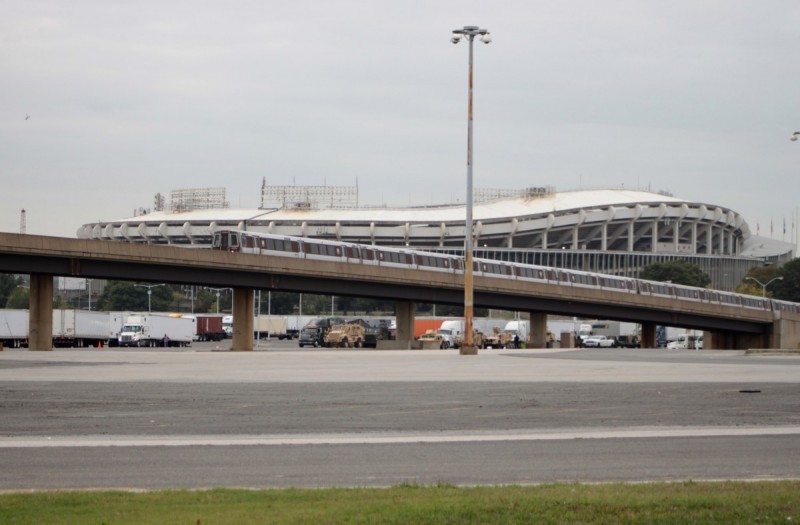NE DC is turning vacant parking lots into playing fields, thanks to these parents
_800_445_90.jpg)
A mockup of the future park and playing fields that will replace the vacant parking lots near RFK stadium. Image by OMA and Robota used with permission.
If you’ve ever tried to organize a sports league for DC kids, you find out quickly that there is no problem finding a supply of interested children. What’s hard is finding a place for them to play.
Some families in Northeast DC couldn’t finding a field nearby, so they found some vacant parking lots nearby and drew up plans for a place for kids to play. After years of work, those parking lots are getting turned into something even grander than neighborhood advocates initially dreamt.
Plans for the area, including playing fields. Image by OMA and Robota used with permission._800_600_90.jpg)
Starting this fall (if the permitting process goes smoothly), parking lots north of RFK Stadium are scheduled to be converted to playing fields, and the field backlog for District kids will be that much shorter. Instead of heat-radiating asphalt, neighbors out for a quiet stroll will be able to cross green space to access the soon-to-be improved Kingman and Heritage Islands.
Here’s how we did it.
Families decided to take matters into their own hands
Field space in the District is at a premium. Even when you can find field space, it’s tough to find out who controls it, or what complicated procedures you have to go through to reserve it. Some fields are controlled by NPS, some by DCPS, some by individual charter schools, some by DC’s DGS, and still others by DCDPR.
A group of parents in my neighborhood (Sanju Misra, Becky Skinner, Al Coles, Ziad Demian, Mike Barrette, Mike Godec, Scotte MacQween, and Larry Kaufer) went looking for more space so their kids could play, and discovered that the parking lots north of RFK Stadium are generally vacant and rarely used.
These parking lots by RFK Stadium often sit empty. Image by SounderBruce licensed under Creative Commons.
The Washington football team abandoned the site in 1996 after negotiations with DC for a new stadium fell through. The team has played in Landover, Maryland since then, but District leaders (including our current and past mayors) have pined for the team’s return, so little has been done with the space.
The group of parents decided to call their idea the Capitol Riverside Youth Sports Park, or “CRYSP.” CRYSP parents knew the first step to realizing their idea would be to get the neighborhood on board. An architect member of the CRYSP, Ziad Demian, made some basic drawings of what they wanted the space to look like.
Then local government got on board…but not without a fight
This is when I became involved. I thought if we, as a neighborhood, don’t put forward a vision for what we want the space to be, someone else will come in and do that for us. After introducing CRYSP at several neighborhood meetings, including a visioning session where neighbors added their ideas for how CRYSP would best fit into the community’s existing landscape, Demian drew up a more detailed design.
Image by Demain/Wilbur/Architects used with permission.
The biggest neighborhood-driven change was moving the project from the area west of the Metro tracks to east between the Metro and the Anacostia River. The neighborhood expressed its support, and the surrounding ANCs followed soon after.
A Resolution of Support was introduced to the Council by then-Councilmember Tommy Wells and Councilmember David Grosso, and Councilmembers Muriel Bowser, David Catania, Mary Cheh, and Kenyan McDuffie signed on. But then the resolution died after it was referred to the Committee on Finance and Revenue.
Events DC, the entity that controls the property, had to weigh in. It was hesitant at first — competing ideas were coming in from other councilmembers, and it could not support something that would prevent the potential return of professional football, given the Mayor’s position. Thanks in large part to Demian’s drawings, Events DC came to see the advantages of CRYSP’s design.
The stadium and CRYSP could cohabitate the 190 acres of the RFK site. The city could save money on impervious surface fees by introducing acres of pervious playing fields instead of impervious pavement. Plus, the area is in a floodplain, which means that habitable structures aren’t really an option.
A victory for grassroots activism
Events DC began its own designs, hiring Brailsford & Dunlavey (B&D) and world-renowned architecture firm OMA. In January 2017, OMA revealed its designs, which include bridges to Kingman and Heritage Islands, a 40,000-square-foot food hall, a sports complex, and an RFK Memorial, plus a giant football stadium or other anchor tenant. But the first item on the list has always been the playing fields.
Mockup of the food hall. Image by OMA and Robota used with permission.
Mockup of recreation area. Image by OMA and Robota used with permission._800_445_90.jpg)
The next step is ensuring that when the fields are ready, they are accessible to the same community groups that asked for them in the first place. Accessible walking trails and benches for seniors, along with some unprogrammed community time — i.e. time not dedicated to organized leagues — are also essentials.
Events DC has been great about listening to the community so far, and we are confident they will continue to do so. As a result, thanks to a group of forward-thinking community members and receptive District officials, acres of pockmarked asphalt will become an active landscape for the entire community to enjoy.
It can’t come soon enough.
